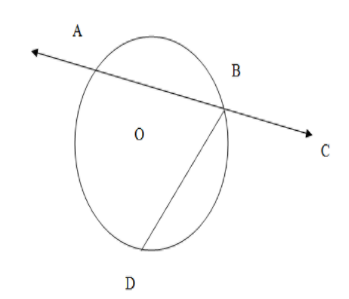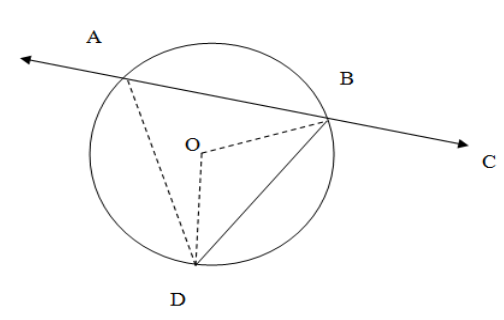
Secant ABC intersects a circle at A and B. Chord $\overline{BD}$ is drawn. Show that $m\angle CBD\ne \dfrac{1}{2}m\widehat{BD}$.\[\]


Answer
568.8k+ views
Hint: We produce BO, DO, AD. We recall the definition of a central angle and have $m\widehat{BD}=m\angle BOD$. We use the relationship between the inscribed angle by an arc and central angle $m\angle BAD=\dfrac{1}{2}m\angle BOD$. We use the external angle theorem in triangle ABD and use obtained relations to prove the given statement $m\angle CBD\ne m\widehat{BD}$
Complete step-by-step solution
We observe the given figure in the question. We have the straight-line $ABC$ which cuts the circle with center O at points A and B. The chord BD has been drawn. We produce BO. DO and AD.

We know the measure of the chord is equal to the angle it subtends at the center with its two radii which is known as the central angle. Here the chord BD makes the angle $\angle BOD$ with the radii BO and CO at the center O.So we have,
\[m\widehat{BD}=m\angle BOD...(1)\]
We also know that the inscribed angle by an arc is the angle the endpoints of the arc subtended at any point on the circle excluding the arc as the vertex. Here the arc BD has endpoints B and D. A is a point not on the arc. The arc BD subtends the inscribed angle $\angle BAD$ at A. We know from the theorem that the inscribed angle is half of the central angle. So we have,
\[m\angle BAD=\dfrac{1}{2}m\angle BOD...(2)\]
We know from the theorem of external angles that the external angle of the triangle is equal to the sum of two remote interior angles. We observe the triangle ABD where the external angle is $\angle CBD$ and its remote internal angles $\angle BAD,\angle ADB$. So we have
\[\begin{align}
& m\angle CBD=m\angle BAD+m\angle ABD \\
& \Rightarrow m\angle CBD=\dfrac{1}{2}m\angle BOD+m\angle ABD\left( \text{from}\left( 2 \right) \right) \\
& \Rightarrow m\angle CBD=\dfrac{1}{2}m\widehat{BD}+m\angle ABD\left( \text{from}\left( 1 \right) \right) \\
& \Rightarrow m\angle CBD>\dfrac{1}{2}m\widehat{BD} \\
\end{align}\]
So hence it is proved that $m\angle CBD\ne \dfrac{1}{2}m\widehat{BD}$\[\]
Note: We note that the inscribed angle by a semicircle is a right angle. We can use the relation between the central angle and the inscribed angle to prove that the opposite angles of a cyclic quadrilateral are supplementary.
Complete step-by-step solution
We observe the given figure in the question. We have the straight-line $ABC$ which cuts the circle with center O at points A and B. The chord BD has been drawn. We produce BO. DO and AD.

We know the measure of the chord is equal to the angle it subtends at the center with its two radii which is known as the central angle. Here the chord BD makes the angle $\angle BOD$ with the radii BO and CO at the center O.So we have,
\[m\widehat{BD}=m\angle BOD...(1)\]
We also know that the inscribed angle by an arc is the angle the endpoints of the arc subtended at any point on the circle excluding the arc as the vertex. Here the arc BD has endpoints B and D. A is a point not on the arc. The arc BD subtends the inscribed angle $\angle BAD$ at A. We know from the theorem that the inscribed angle is half of the central angle. So we have,
\[m\angle BAD=\dfrac{1}{2}m\angle BOD...(2)\]
We know from the theorem of external angles that the external angle of the triangle is equal to the sum of two remote interior angles. We observe the triangle ABD where the external angle is $\angle CBD$ and its remote internal angles $\angle BAD,\angle ADB$. So we have
\[\begin{align}
& m\angle CBD=m\angle BAD+m\angle ABD \\
& \Rightarrow m\angle CBD=\dfrac{1}{2}m\angle BOD+m\angle ABD\left( \text{from}\left( 2 \right) \right) \\
& \Rightarrow m\angle CBD=\dfrac{1}{2}m\widehat{BD}+m\angle ABD\left( \text{from}\left( 1 \right) \right) \\
& \Rightarrow m\angle CBD>\dfrac{1}{2}m\widehat{BD} \\
\end{align}\]
So hence it is proved that $m\angle CBD\ne \dfrac{1}{2}m\widehat{BD}$\[\]
Note: We note that the inscribed angle by a semicircle is a right angle. We can use the relation between the central angle and the inscribed angle to prove that the opposite angles of a cyclic quadrilateral are supplementary.
Recently Updated Pages
Two men on either side of the cliff 90m height observe class 10 maths CBSE

What happens to glucose which enters nephron along class 10 biology CBSE

Cutting of the Chinese melon means A The business and class 10 social science CBSE

Write a dialogue with at least ten utterances between class 10 english CBSE

Show an aquatic food chain using the following organisms class 10 biology CBSE

A circle is inscribed in an equilateral triangle and class 10 maths CBSE

Trending doubts
Why is there a time difference of about 5 hours between class 10 social science CBSE

Write a letter to the principal requesting him to grant class 10 english CBSE

What is the median of the first 10 natural numbers class 10 maths CBSE

The Equation xxx + 2 is Satisfied when x is Equal to Class 10 Maths

Which of the following does not have a fundamental class 10 physics CBSE

State and prove converse of BPT Basic Proportionality class 10 maths CBSE




